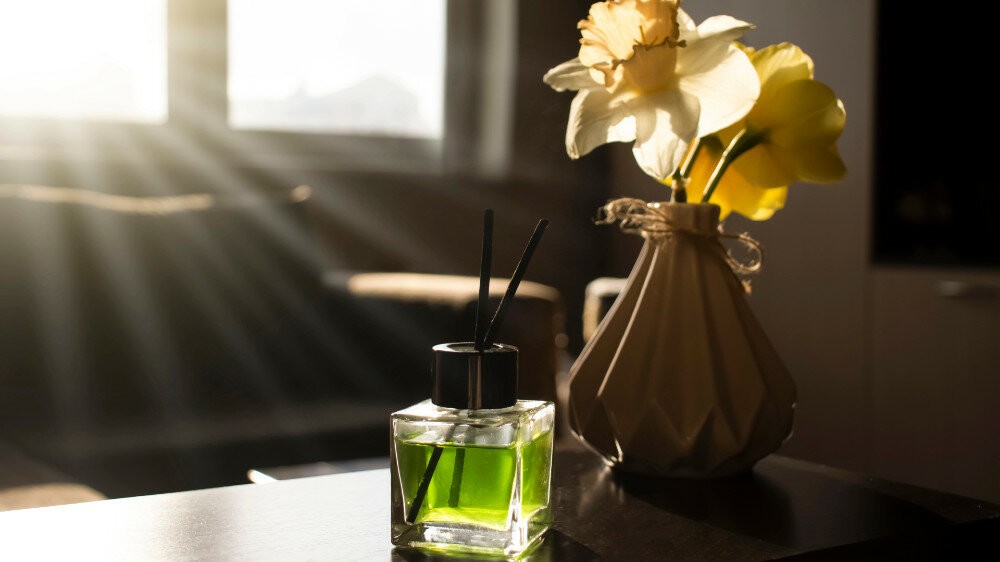Before we see a room, we smell it. Our brains register scent faster than sight or sound, and that invisible first impression can instantly shift our emotional state. A whisper of vanilla might wrap you in comfort while eucalyptus can feel like a breath of renewal. The smell of citrus can awaken you, while sandalwood steadies your pulse. Fragrance is memory, emotion, and atmosphere all in one inhale.
In recent years, scent has evolved beyond perfume counters and spa menus. It’s become a design element, a wellness ritual, and a form of self-expression. People are using candles, oil diffusers, incense, air fresheners, and even car fragrances to curate how they feel at home, at work, and on the road. It’s mood design by way of molecules.
The Science Behind the Scents
Smell is our most primal sense. The olfactory nerve is the only one that connects directly to the brain’s limbic system, the area responsible for emotion and memory. That’s why scent bypasses logic and hits us where we live. One breath, and we’re in another place or time.
Certain aromas consistently trigger specific effects. Lavender, chamomile, and clary sage relax the nervous system. Citrus oils like lemon, orange, and grapefruit elevate mood and boost alertness. Peppermint and rosemary sharpen focus. Vanilla and tonka bean comfort the senses, while cedarwood and sandalwood ground us when we get a little too excited.
These associations aren’t just poetic, they’re physiological. Aromatic compounds interact with brain receptors that influence heart rate, cortisol levels, and even our own digestion. Which means that “lighting a candle to relax” isn’t just indulgent, it’s neurochemistry at work.
Home: The Heart of Scent Styling
Fragrance has become just as central to interior design as lighting or color. In each room, it can signal a different emotional cue, guiding how we move through the day.
The Entryway: Bright Beginnings
A fresh, clean scent in your entryway is like a friendly handshake for the senses. Notes of bergamot, lemon, or rosemary instantly clear mental clutter and mark the threshold between the outside world and your personal sanctuary. Reed diffusers or gentle plug-in warmers (from brands like Glade) work perfectly here. They quietly scent the air around the clock without demanding attention and at an affordable price.
The Living Room: Comfort and Connection
This is where we gather, unwind, and connect. Warm, enveloping notes like fig, sandalwood, amber, or cashmere musk help create a cozy atmosphere that invites lingering. Candles excel in this space, both for their soft glow and their ability to layer scent and ambiance. Try lighting one 20 minutes before guests arrive. The flickering flame sets the tone before your guests can even sit down.
The Kitchen: Clean and Inviting
The kitchen deserves fragrance that supports rather than competes with cooking. Citrus and herbs are your best friends. Think lemon, basil, mint, and cypress to feel fresh and cut through lingering odors. After dinner, you can switch to something richer, like a cardamom-and-orange candle, which evokes dessert without being cloying.
The Bedroom: A Haven for Rest
Bedrooms are for slowing down. Soft florals like jasmine or neroli, combined with calming herbs such as lavender or chamomile, promote relaxation and sleep. Try a mist diffuser with a 30-minute timer or a few drops of oil on a linen pillow spray. For romance, add a touch of vanilla or ylang-ylang. These are notes proven to trigger feelings of warmth and intimacy.
When Talia Mendoza, a wellness coach in Portland, started struggling with sleep, she didn’t buy fancy new sheets, she bought a diffuser. “I read that lavender helps, but I didn’t want my room to smell like a candle shop,” she says. So she blended lavender, chamomile, and a drop of vanilla, and set the timer for thirty minutes before bed. “Now, that smell tells my body it’s time to power down,” she explains. “Even my dog curls up faster.”
The Bathroom: Everyday Spa
Even a tiny bathroom can feel like a retreat with the right scent. Think eucalyptus, tea tree, or sea salt. These are all crisp, invigorating, and clean. Reed diffusers are ideal for maintenance, while a stick of hinoki incense before a bath transforms the space into your own personal spa moment.
The Workday Fragrance Effect
In an era of hybrid work and long hours staring at screens, scent has become a subtle productivity tool. In offices or home workspaces, fresh and herbal notes can help sustain focus. Peppermint has been shown to enhance memory recall, while grapefruit boosts energy and creativity.
Start your morning with a bright blend of citrus and mint to jumpstart alertness. As the day wears on, shift to grounding scents like cedarwood, vetiver, or patchouli to stay centered. If you share your workspace, keep it subtle unless you like making enemies. A small ultrasonic diffuser on a low setting or a personal essential-oil roller on your wrist is enough to cue your brain without overwhelming coworkers with sensitive noses.
Scent can also serve as a boundary. Try lighting a gentle candle or burning incense at the end of your workday. The fragrance marks the transition from “doing” to “being,” telling your body that it’s time to step out of work mode and exhale.
On the Road: Your Car, Your Capsule
Cars have their own mood language. Once synonymous with harsh pine tree air fresheners or synthetic “new car” sprays, the modern car scent experience is softer and more personal.
Vent clips infused with essential oils let you shift gears emotionally while you drive. During morning commutes, lavender and mandarin create calm focus. On weekends, woody and citrus blends like cedar and lemon signal adventure on the horizon. If you’re driving long distances, mint or eucalyptus can help maintain alertness without over-stimulation.
Because the cabin is such a small space, rotate air freshener scents seasonally so your nose doesn’t tune them out. Crisp greens in spring, breezy florals in summer, spiced woods in winter. Companies like Custom Comet, which makes custom car fresheners, have increased their scent library considerably to meet this new demand. Your car can feel like an extension of your home’s energy, not just a metal box between destinations.
Perfume: The Mood You Wear
Scent is also deeply personal. It’s the invisible accessory we wear to the world. Many women today are moving away from a single “signature scent” and embracing a fragrance wardrobe, selecting perfumes by mood rather than brand loyalty.
A sparkling citrus floral might be your Monday morning armor, helping you feel awake and capable. On a Sunday afternoon, you might reach for something creamy and comforting, for instance, a blend of vanilla, almond milk, and white musk. Nighttime could call for a more mysterious profile of amber, oud, or patchouli.
Perfume layering is also on the rise by pairing a woodsy base with a floral top note, or echoing your home’s scent in your personal fragrance. Wearing a sandalwood perfume while burning a sandalwood candle creates a continuous sensory thread that makes life feel more cohesive and intentional.
Incense, Ritual, and the Art of the Pause
Incense, once relegated to yoga studios, meditation corners, and college dorms, has reemerged in elegant, modern forms. Low-smoke blends of hinoki, vetiver, or black tea can turn five minutes of quiet into a grounding ritual. Lighting incense at the end of the day, watching the tendrils of smoke curl and vanish, creates a tactile reminder to let go.
The appeal lies in ritual as much as aroma. It’s about creating tiny anchors in time. Light the stick, take three slow breaths, reset. Fragrance becomes mindfulness in motion.
Clean Burn, Clear Conscience
As our awareness of air quality grows, so does the clean-scent movement. Consumers now seek candles made with soy or coconut wax, cotton or wood wicks, and phthalate-free oils. Brands are reformulating with transparency, listing every ingredient and ditching synthetic stabilizers.
Even incense and diffusers are following suit. Many use biodegradable bamboo sticks and essential oils rather than synthetic fragrances. These improvements make scent not only safer but more enjoyable. Fewer headaches, purer burn, and longer-lasting fragrance.
If you’re sensitive to strong perfume, lean into “nearly neutral” profiles like linen, paper, rain, or white tea. They freshen air without dominating it, giving a sense of clarity that feels clean rather than perfumed.
Fragrance as Everyday Ritual
The magic of scent lies in its ability to turn ordinary routines into moments of care. Lighting a candle when you start cooking dinner signals comfort. A few drops of peppermint oil while answering emails transforms your mindset. A fresh hanging car air freshener on the first of the month becomes a miniature reset.
Over time, these scents become emotional shorthand for stability, pleasure, and presence. You begin to associate lavender with rest, citrus with optimism, cedar with strength. The air around you becomes a silent, supportive ally.
Fragrance doesn’t just decorate space, it choreographs life. It can make your home feel more like a sanctuary, your office a place of clarity, and your commute a moment of calm. Every scent you choose is a small act of self-direction, an invisible thread weaving mood into your day.
So light the candle, mist the oil, or hang the air freshener from your rearview mirror. You’re not just filling the air, you’re shaping the way you feel in it. And that, perhaps, is the most beautiful design choice of all.




